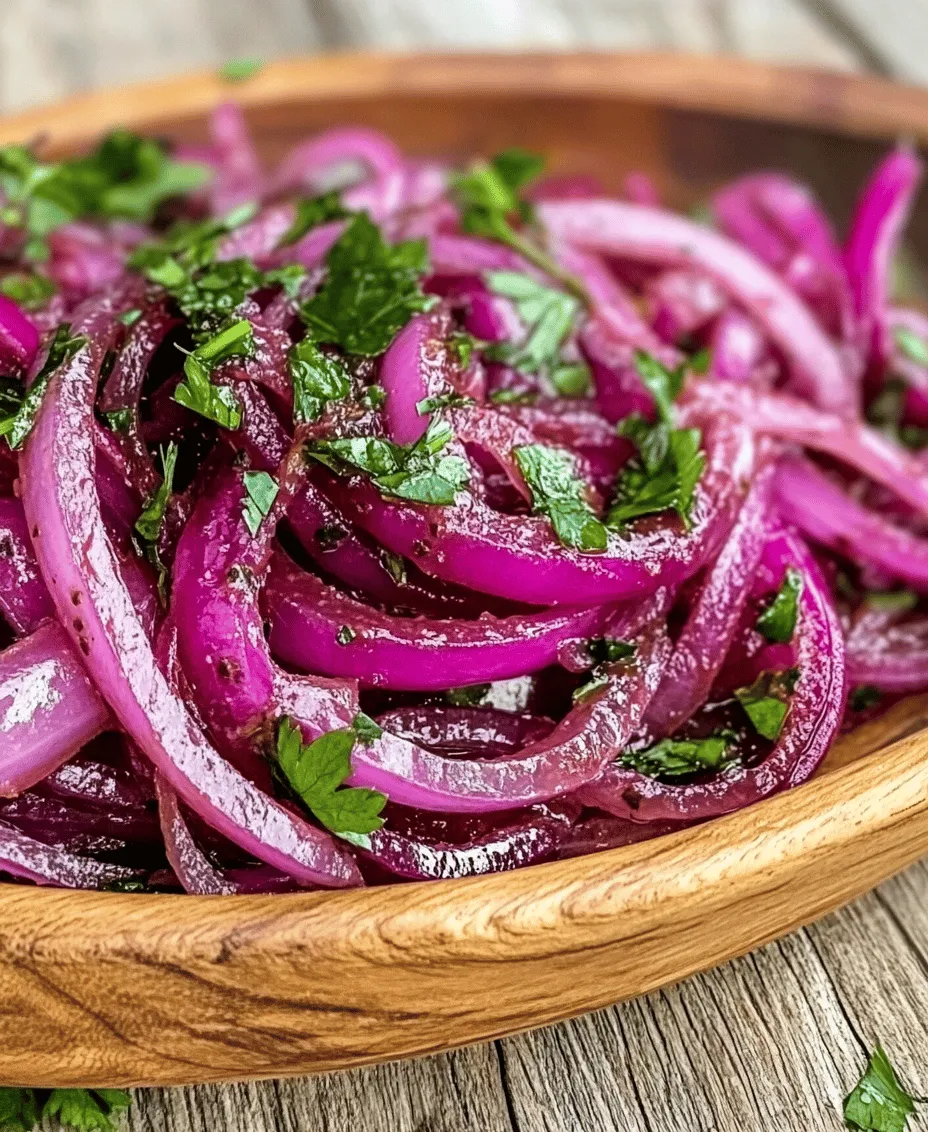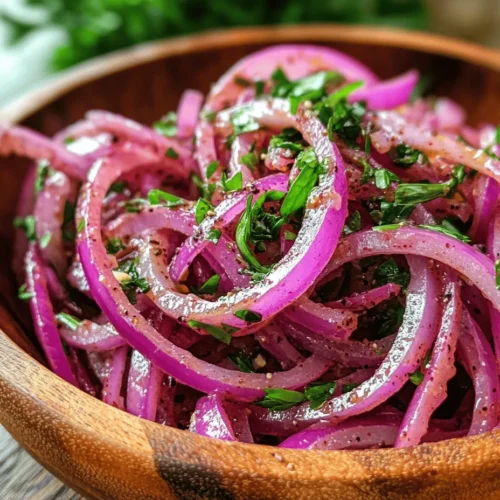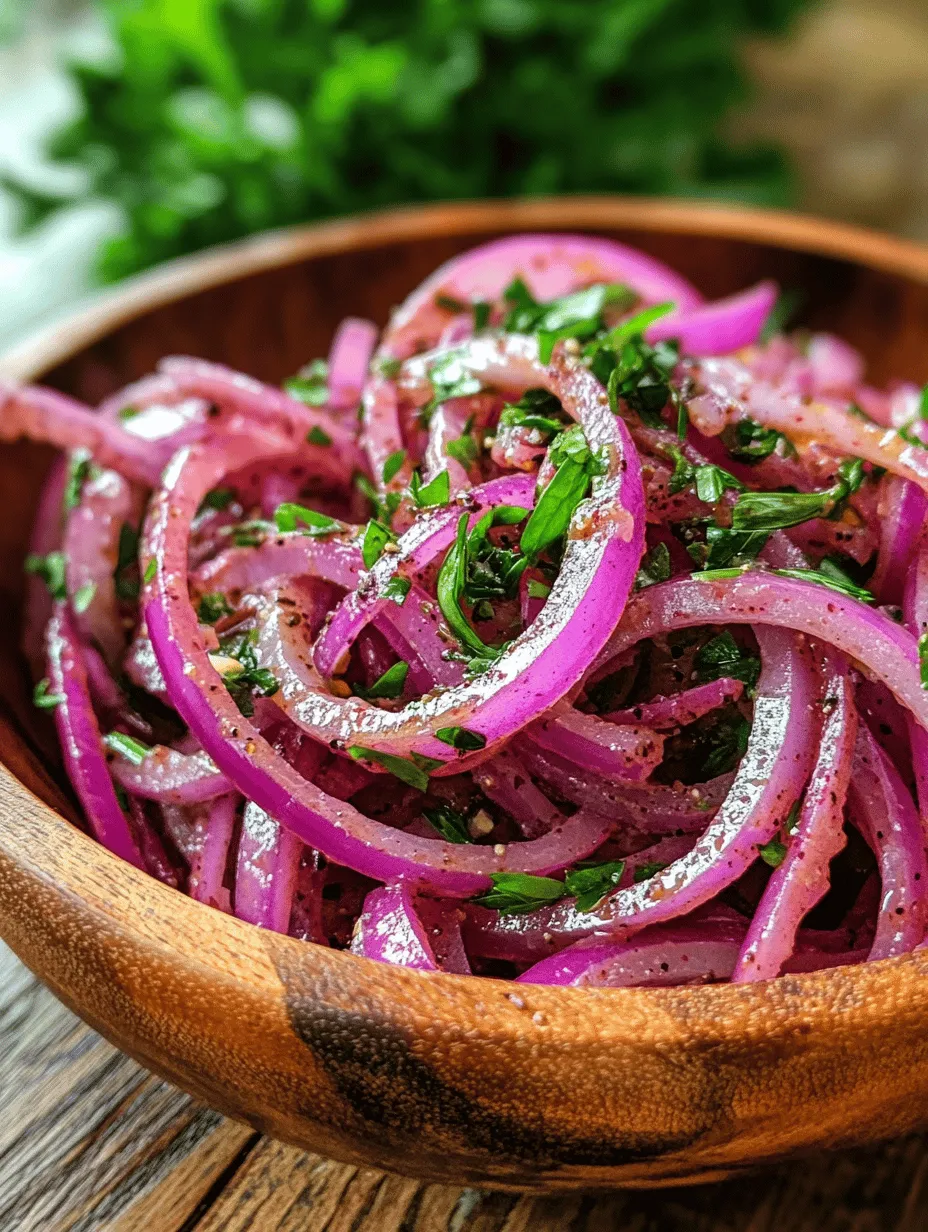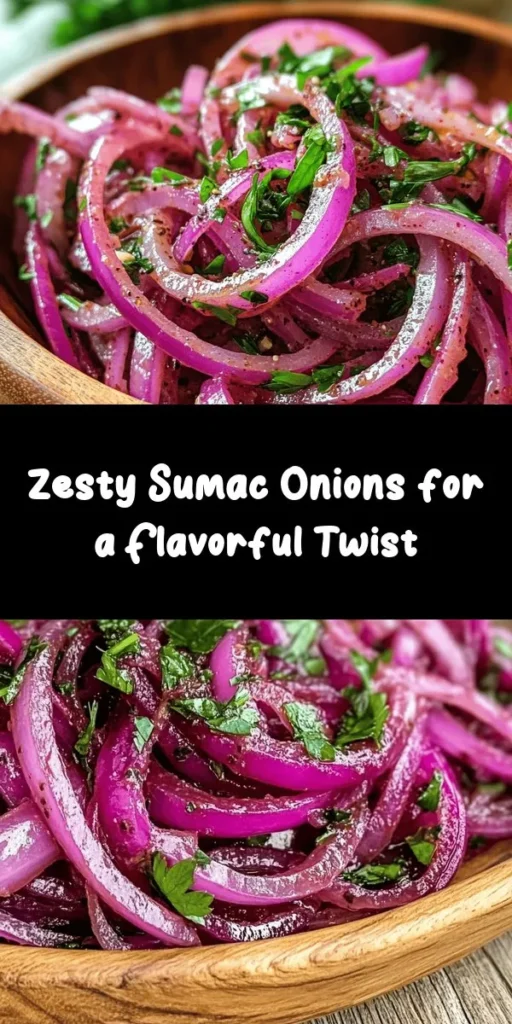In the world of culinary delights, few ingredients can elevate a dish quite like the vibrant and tangy flavor of sumac. This Middle Eastern spice, with its deep crimson hue and lemony undertones, pairs beautifully with the sharpness of red onions, creating a dish that is as refreshing as it is versatile. Sumac has been a staple in Mediterranean cooking for centuries, prized not only for its distinctive flavor but also for its health benefits, including antioxidant properties and a potential role in reducing inflammation. As we delve into the delightful recipe for Sumac Onions, you’ll discover how this simple yet impactful preparation can enhance a variety of meals. Whether you’re looking to add a zesty side dish to your grilled meats, a flavorful topping for wraps, or a unique component to salads, this recipe is sure to impress.
Understanding Sumac and Its Culinary Uses
Exploring the Origins of Sumac
Sumac is derived from the dried and ground berries of the sumac shrub, primarily found in the Mediterranean region, the Middle East, and parts of North America. The use of sumac dates back thousands of years, with historical references linking it to ancient civilizations, including the Romans and Greeks, who recognized its culinary and medicinal properties. In Middle Eastern cuisine, sumac is often used as a souring agent, akin to lemon juice or vinegar, lending a bright acidity to dishes that can enhance flavors and balance richness.
Highlighting the Flavor Profile of Sumac
The flavor profile of sumac is unique and complex. It possesses a tartness that is reminiscent of lemon, yet it also carries a subtle earthiness that sets it apart from other souring agents. This combination makes sumac incredibly versatile, allowing it to complement a wide range of ingredients. When combined with the sweetness of red onions, sumac brings a refreshing contrast that invigorates the palate, making it an ideal ingredient for salads, grilled meats, and even dips.
Culinary Applications of Sumac in Various Cuisines
Sumac is celebrated in a variety of cuisines beyond just Middle Eastern cooking. In Mediterranean dishes, it can be sprinkled over grilled vegetables, used in spice blends like za’atar, or incorporated into marinades for meats. In Turkish cuisine, sumac is often used in salads and is a common seasoning for kebabs. Its versatility extends to modern culinary trends, where chefs use sumac to elevate contemporary dishes, infusing them with a delightful tang. This adaptability makes sumac a must-have in any home cook’s spice cabinet.
Unpacking the Ingredients for Sumac Onions Delight
The Star Ingredient: Red Onions
Red onions are the star of our Sumac Onions Delight, bringing their vibrant color and sharp flavor to the forefront. Unlike their yellow and white counterparts, red onions have a milder taste, which becomes even sweeter when caramelized or marinated. Their natural sweetness pairs beautifully with the tangy notes of sumac, making them an ideal choice for this dish. When selecting red onions, look for firm bulbs with smooth, unblemished skin to ensure maximum freshness and flavor.
The Role of Sumac in Flavor Enhancement
As we previously discussed, sumac is the key ingredient that transforms simple red onions into a deliciously zesty dish. Its tartness cuts through the pungency of the onions, lending a refreshing quality that makes this preparation stand out. When sumac is sprinkled on the onions, it not only enhances their flavor but also adds a vibrant hue, making the dish visually appealing. The balance of flavors creates an unforgettable taste experience that can elevate any meal.
The Importance of Olive Oil and Lemon Juice
Olive oil and lemon juice play a crucial role in the preparation of Sumac Onions. Olive oil adds richness and depth, helping to soften the onions while allowing the flavors to meld together harmoniously. Lemon juice, with its bright acidity, enhances the tang of the sumac and adds an extra layer of freshness to the dish. Together, these ingredients create a dressing that coats the onions beautifully, ensuring that every bite is infused with flavor.
Seasoning Essentials: Salt and Pepper
No dish is complete without the essential seasoning of salt and pepper. In the case of Sumac Onions Delight, salt helps to draw out moisture from the onions, intensifying their flavor and leading to a more pronounced sweetness. A pinch of freshly cracked black pepper adds a subtle kick, balancing the tanginess of the sumac and the sweetness of the onions. It’s important to season thoughtfully, as the goal is to enhance the natural flavors of the ingredients without overpowering them.
Sweetness Factor: Honey or Maple Syrup
To further balance the dish, a touch of sweetness from honey or maple syrup can be added, depending on your preference. This addition complements the sharpness of the onions and the tartness of the sumac, creating a well-rounded flavor profile. Honey, with its floral notes, pairs beautifully with the earthiness of sumac, while maple syrup adds a unique depth that can elevate the dish to new heights. Use these sweeteners sparingly, allowing the natural flavors to shine through.
Garnishing with Fresh Parsley
Finally, no dish is complete without a pop of color and freshness from herbs. Fresh parsley not only adds visual appeal but also contributes a hint of bitterness that can balance the sweetness of the onions and honey. Chopped parsley can be sprinkled over the finished dish to enhance its presentation and provide an aromatic touch that complements the other ingredients beautifully.
Step-by-Step Guide to Preparing Sumac Onions
Preparation of Red Onions: Slicing Techniques
To begin, the first step in preparing your Sumac Onions Delight is to slice the red onions. For this dish, it’s best to slice the onions thinly to ensure they absorb the flavors of the dressing effectively. Using a sharp knife, cut off the ends of the onion and peel away the outer skin. Then, slice the onion in half from top to bottom, placing the cut side flat on the cutting board for stability. Proceed to slice each half into thin half-moon shapes, aiming for uniformity in size to promote even marination.
Creating the Sumac Dressing: Mixing the Ingredients
Once your onions are sliced, it’s time to create the sumac dressing. In a mixing bowl, combine the sliced red onions with a generous sprinkle of sumac, a drizzle of high-quality olive oil, and the freshly squeezed juice of one lemon. If you choose to add honey or maple syrup for sweetness, include it at this stage as well. Season with salt and pepper to taste. Gently toss the mixture with your hands or a spoon, ensuring that each slice of onion is evenly coated with the dressing. Allow the onions to marinate for at least 15 minutes, giving the flavors time to meld and the onions to soften.
As you prepare this delightful dish, you’ll notice how the sumac not only enhances the flavor but also adds a beautiful color to the onions, making them a visually appealing addition to any meal. The vibrant hues of red and purple will make your Sumac Onions Delight a standout accompaniment on your dinner table.
—
As we continue to explore the intricacies of Sumac Onions Delight, we will delve deeper into serving suggestions, potential variations, and tips for perfecting this refreshing dish in the following sections. This simple yet flavorful preparation is sure to become a favorite in your culinary repertoire, enhancing your meals with its zesty kick and vibrant colors. Stay tuned for the next part of this delicious journey!

Marinating for Maximum Flavor: The Importance of Time
When it comes to infusing flavor into your Sumac Onions Delight, marinating is an essential step that should not be overlooked. The key to achieving that vibrant taste lies in allowing the onions to soak up the flavors of sumac, lemon, and olive oil over time. Ideally, you should let the onions marinate for at least 30 minutes to an hour before serving. This resting time allows the onions to soften, mellowing their sharpness while absorbing the tangy and citrusy notes from the marinade.
If time permits, consider marinating the onions overnight. This extended period will amplify the flavors even more, resulting in a dish that bursts with zest and brightness. Just make sure to store the marinated onions in an airtight container in the refrigerator to maintain freshness. Whether you opt for a quick marinate or a longer soak, this step is pivotal in transforming your dish into a flavorful delight.
Final Touches: Adjusting Seasonings and Garnishing
Once your onions have marinated to perfection, taste them to check if any adjustments are needed. Depending on your personal preference, you may want to add a pinch more salt or a dash of extra sumac for an enhanced flavor profile. Remember, the goal is to strike a balance between the tanginess of the sumac and the sweetness of the onions.
For garnishing, consider adding fresh herbs such as chopped parsley or cilantro to introduce a hint of freshness that complements the dish. A sprinkle of pomegranate seeds can also add a beautiful pop of color and a touch of sweetness. These final touches not only enhance the visual appeal of your Sumac Onions Delight but also elevate the overall flavor experience.
Flavor Pairings and Serving Suggestions
Sumac Onions are incredibly versatile and can complement a wide array of dishes. Here are several serving suggestions to incorporate this delightful recipe into your meals:
Serving Sumac Onions with Grilled Meats
One of the most popular ways to enjoy Sumac Onions is as a topping for grilled meats. The bright acidity of the onions pairs beautifully with the smoky flavors of grilled chicken, lamb, or beef. Simply serve the marinated onions alongside your favorite grilled dish. The zesty flavor from the sumac and the crunchiness of the onions will cut through the richness of the meat, creating a well-balanced meal.
Incorporating Sumac Onions in Salads
Another fantastic way to enjoy Sumac Onions is by tossing them into salads. They work particularly well in Mediterranean-style salads, where their tangy flavor can enhance the freshness of cucumbers, tomatoes, and feta cheese. You can also add them to grain-based salads, such as quinoa or bulgur, for an extra layer of flavor. The sumac-infused dressing from the marinated onions can serve as a delicious vinaigrette for your salad, ensuring every bite is bursting with flavor.
Using as a Topping for Wraps and Sandwiches
Sumac Onions make a delicious topping for wraps and sandwiches. Their vibrant flavor can elevate a simple wrap filled with grilled vegetables, chicken, or falafel. Spread a layer of hummus or tzatziki on your wrap, add your protein of choice, and finish with a generous scoop of marinated onions. The result is a satisfying and flavorful meal that’s both nutritious and fulfilling.
Pairing with Middle Eastern Dishes
Inspired by the traditional use of sumac in Middle Eastern cuisine, consider serving your Sumac Onions with classic dishes such as kebabs, shawarma, or falafel. They add a refreshing contrast to hearty dishes and bring an authentic touch to your meal. For a complete Middle Eastern feast, pair the onions with warm pita bread, creamy hummus, and a side of tabbouleh or fattoush salad.
Nutritional Benefits of Sumac Onions
Health Benefits of Red Onions
Red onions are not only flavorful but also packed with nutrients. They are rich in antioxidants, particularly quercetin, which has anti-inflammatory properties. This can help in reducing the risk of chronic diseases and boosting overall health. Additionally, red onions are a great source of vitamins C and B6, which contribute to immune health and energy metabolism. They also contain dietary fiber, which aids in digestion and supports heart health.
Nutritional Contributions of Sumac
Sumac, the star ingredient in this dish, is a spice derived from the dried berries of the sumac plant. It offers a distinctive tangy flavor while also being low in calories. Sumac is known for its high antioxidant content, which can help combat oxidative stress in the body. Additionally, it has anti-inflammatory properties and may support digestive health. Incorporating sumac into your diet can provide a flavorful way to reap these health benefits.
Balancing Flavors and Nutrition in Your Meal
Combining sumac with onions creates a dish that is not only delicious but also nutritious. The acidity from the sumac enhances the natural sweetness of the onions, making it an ideal condiment for various meals. When you serve Sumac Onions alongside protein-rich foods and fresh vegetables, you create a balanced meal that is satisfying and health-conscious.
Culinary Variations of Sumac Onions
While the basic recipe for Sumac Onions is already delightful, there are numerous culinary variations you can explore:
Exploring Different Onion Varieties
Don’t feel limited to just red onions; you can experiment with different onion varieties to create unique flavor profiles. White onions offer a sharper taste, while yellow onions provide a sweet flavor when marinated. Green onions can add a mild, fresh bite to the dish. Feel free to mix and match various types of onions to discover your favorite combination.
Adding Spices for a Unique Twist
For a more complex flavor profile, consider adding spices to the marinade. A pinch of cumin or coriander can introduce warmth and depth to the dish. If you enjoy a little heat, a dash of cayenne pepper or red pepper flakes can elevate the flavor and add a spicy kick. Just be mindful of balancing the heat with the tanginess of the sumac.
Incorporating Additional Vegetables
You can also enhance your Sumac Onions by incorporating additional vegetables. Sliced bell peppers, cucumbers, or even grated carrots can add color and crunch to the dish. These vegetables will not only complement the onions but will also create a vibrant and nutritious medley that can be enjoyed as a side or added to salads and wraps.
Conclusion
Sumac Onions Delight is more than just a side dish; it is a celebration of flavors that can transform ordinary meals into extraordinary culinary experiences. This simple yet sophisticated dish not only highlights the unique taste of sumac but also showcases the versatility of onions in enhancing various dishes. Whether served alongside grilled meats, tossed into salads, or used as a topping for wraps, Sumac Onions offer a refreshing zing that is sure to tantalize the taste buds. Embrace the vibrant flavors of this recipe and enjoy the delightful experience it brings to your dining table. With its nutritional benefits and culinary flexibility, Sumac Onions Delight is a dish you’ll want to incorporate into your regular meal rotation. So gather your ingredients, let the onions marinate, and savor the delicious flavors that await you!



